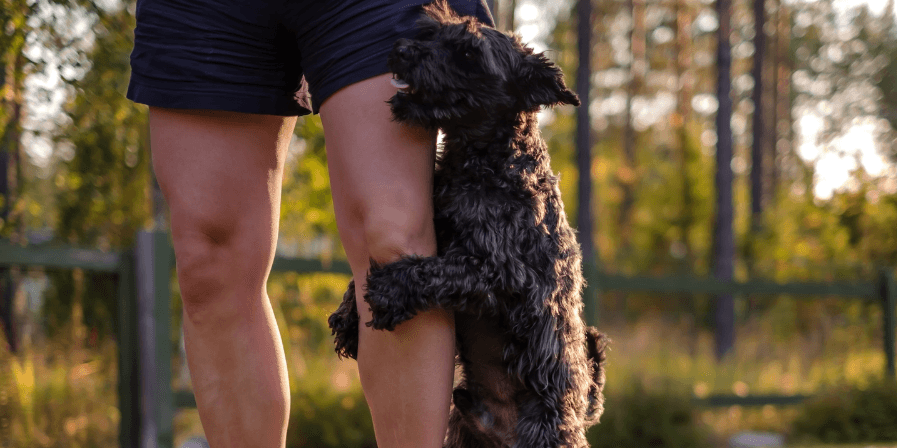Why Do Dogs Hump?

Dogs humping is a common yet often misunderstood behavior. Many pet owners assume it’s strictly a sexual action, but humping, also known as mounting, can occur for various reasons. It can be seen in both male and female dogs, regardless of whether they are spayed or neutered. While sometimes embarrassing, humping is a natural dog behavior that can stem from excitement, dominance, playfulness, or even medical issues. Understanding the underlying causes of this behavior can help pet parents address it appropriately.
Reasons Why Dogs Hump
1. Hormones
In unneutered and unspayed dogs, humping is often related to reproductive instincts. It is more common in intact male dogs, but female dogs can also exhibit this behavior, especially when they are in heat. Even after spaying or neutering, some dogs may continue to hump due to ingrained habits formed before the procedure.
2. Excitement or Overstimulation
Dogs may mount when they are overly excited or aroused, often in response to playtime, meeting new people, or encountering other animals. It’s a way for them to release pent-up energy. You might notice your dog humping when guests arrive, during a fun play session, or when they receive excessive attention.
3. Social and Dominance Behavior
Humping can be a way for dogs to establish dominance over other animals or even people. It is not necessarily an aggressive behavior but rather a way for dogs to assert their social ranking. This type of humping is more common in multi-dog households or when a dog is introduced to a new environment.
4. Habitual or Learned Behavior
Some dogs develop a habit of humping simply because they’ve learned that it gets attention or feels good. If a dog humps frequently and has been unintentionally reinforced (such as through laughter or attention), they may continue the behavior even when it’s not necessary.
5. Stress or Anxiety
Humping can also be a coping mechanism for dogs dealing with stress, boredom, or anxiety. If a dog is feeling overwhelmed, they might mount objects, people, or other dogs as a way to self-soothe. This is similar to how some dogs chew on things or excessively lick their paws when anxious.
6. Medical Issues
In some cases, frequent humping can indicate an underlying medical condition, such as urinary tract infections, skin allergies, or priapism (prolonged erections). Dogs with hormonal imbalances may also exhibit excessive mounting behavior. If a dog suddenly starts humping more than usual, a vet check-up is recommended to rule out medical concerns.
How to Manage Humping Behavior
Training and Redirection
One of the best ways to manage humping is through positive reinforcement training. Teaching commands like "leave it" or "sit" can help distract your dog when they start mounting. Providing alternative activities such as playing with toys or going for a walk can redirect their energy.
Neutering or Spaying
If a dog’s humping is linked to sexual behavior, neutering or spaying may reduce the frequency of mounting. However, this is not a guaranteed solution, as some dogs continue the habit out of learned behavior.
Socialization and Exercise
Ensuring that your dog has enough physical and mental stimulation can help reduce excessive humping. Regular walks, playtime, and interaction with other well-behaved dogs can help channel their energy in a positive way.
Reducing Stress and Anxiety
If stress or anxiety is a trigger, identifying the cause and providing comfort is essential. Calming techniques such as providing a safe space, using pheromone diffusers, or engaging in interactive play can help alleviate anxious behaviors.
When to See a Veterinarian
If humping is excessive, obsessive, or accompanied by other symptoms such as licking the genital area, whining, or frequent urination, it may be a sign of a medical issue. Consulting a veterinarian can help determine if there is an underlying health concern.
Conclusion
Humping is a natural dog behavior with multiple causes, ranging from excitement and dominance to stress and medical issues. While it may be embarrassing for pet owners, understanding why dogs hump can help address the behavior appropriately. With proper training, socialization, and, if necessary, veterinary care, humping can be managed effectively, ensuring a happier and healthier life for your pet. If you’re concerned about your dog’s behavior, DCC Animal Hospital provides expert veterinary consultations to help assess and manage your pet’s needs. Book an appointment today for professional guidance.
FAQs
1. Can a dog outgrow humping?
Yes, many puppies exhibit humping as part of their early social development and may naturally outgrow the behavior as they mature. However, if the behavior is reinforced or becomes habitual, training may be needed to curb it.
2. Does neutering stop dogs from humping?
Neutering can reduce humping caused by hormonal urges, but it may not eliminate the behavior entirely. Dogs may continue to hump due to excitement, learned behavior, or social interactions. Proper training and redirection are key to managing it effectively.


 How can we help?
How can we help?